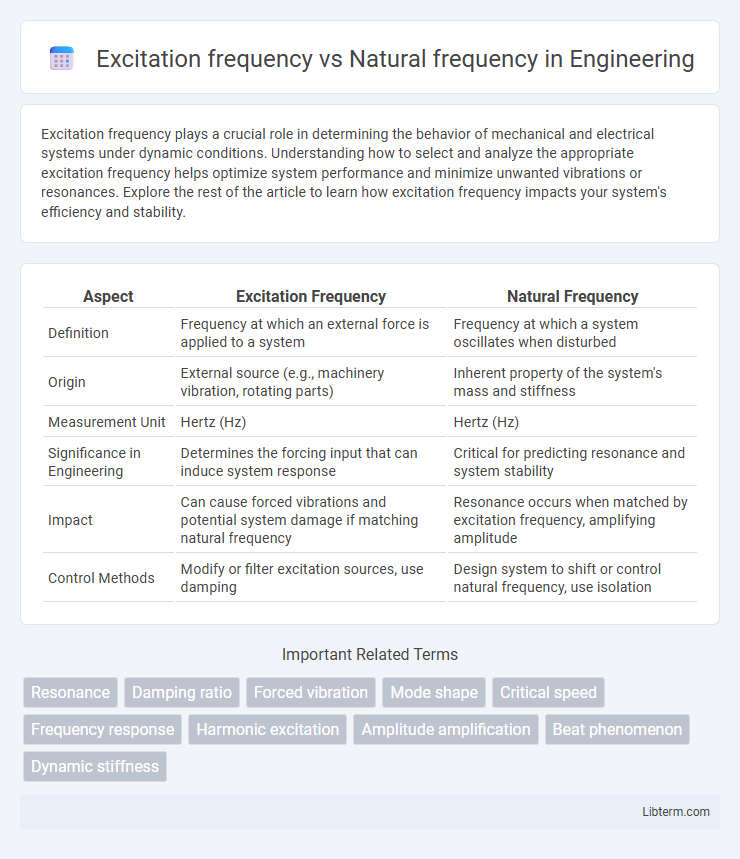Excitation frequency plays a crucial role in determining the behavior of mechanical and electrical systems under dynamic conditions. Understanding how to select and analyze the appropriate excitation frequency helps optimize system performance and minimize unwanted vibrations or resonances. Explore the rest of the article to learn how excitation frequency impacts your system's efficiency and stability.
Table of Comparison
| Aspect | Excitation Frequency | Natural Frequency |
|---|---|---|
| Definition | Frequency at which an external force is applied to a system | Frequency at which a system oscillates when disturbed |
| Origin | External source (e.g., machinery vibration, rotating parts) | Inherent property of the system's mass and stiffness |
| Measurement Unit | Hertz (Hz) | Hertz (Hz) |
| Significance in Engineering | Determines the forcing input that can induce system response | Critical for predicting resonance and system stability |
| Impact | Can cause forced vibrations and potential system damage if matching natural frequency | Resonance occurs when matched by excitation frequency, amplifying amplitude |
| Control Methods | Modify or filter excitation sources, use damping | Design system to shift or control natural frequency, use isolation |
Introduction to Excitation and Natural Frequencies
Excitation frequency refers to the rate at which an external force or input periodically acts on a system, influencing its dynamic response. Natural frequency is the inherent vibration rate at which a system tends to oscillate when disturbed without continuous external force. Understanding the interplay between excitation frequency and natural frequency is crucial for predicting resonance phenomena and ensuring structural integrity in engineering applications.
Defining Excitation Frequency
Excitation frequency refers to the rate at which an external force or input signal is applied to a system, often measured in hertz (Hz). It is a critical parameter in mechanical and structural engineering as it influences a system's dynamic response when interacting with its natural frequency. Understanding excitation frequency helps predict resonance conditions, where the external forcing frequency matches the system's natural frequency, causing significant amplitude increases.
Understanding Natural Frequency
Natural frequency refers to the inherent rate at which a system oscillates when disturbed from its equilibrium position without external force. Understanding natural frequency is crucial for predicting resonance, which occurs when the excitation frequency matches this natural frequency, causing amplified oscillations. Engineers analyze natural frequency to design structures and mechanical systems that avoid resonance-related failures.
Key Differences Between Excitation and Natural Frequency
Excitation frequency refers to the rate at which an external force or vibration is applied to a system, while natural frequency is the inherent frequency at which a system tends to oscillate when disturbed. A critical difference is that resonance occurs when the excitation frequency matches the natural frequency, causing amplified oscillations and potential structural failure. Engineering designs aim to avoid this matching to prevent damage by controlling excitation forces or altering the system's natural frequency through material or shape modifications.
Relationship in Vibrating Systems
In vibrating systems, excitation frequency refers to the rate at which an external force is applied, while natural frequency is the inherent rate at which the system tends to oscillate when disturbed. When the excitation frequency matches the natural frequency, resonance occurs, leading to maximum amplitude vibrations and potential structural damage. Understanding the relationship between these frequencies is crucial for designing systems that avoid resonance and ensure operational stability.
Effects of Frequency Matching: Resonance
Resonance occurs when the excitation frequency matches the natural frequency of a system, causing a significant amplification of vibration amplitude. This frequency matching leads to increased energy transfer into the system, which can induce excessive oscillations and potential structural damage. Engineering designs must carefully consider the natural frequencies to avoid resonance and ensure system stability and longevity.
Real-World Examples and Applications
Excitation frequency refers to the external force frequency applied to a system, while natural frequency is the inherent vibration frequency of that system without external forcing. In real-world applications like bridges and buildings, resonance occurs when excitation frequency matches natural frequency, causing significant amplification of vibrations, as seen in the Tacoma Narrows Bridge collapse. Mechanical devices such as rotating machinery and vehicle suspensions are designed to avoid resonance by tuning natural frequencies away from common excitation frequencies to prevent structural damage and ensure operational stability.
Methods for Measuring Frequencies
Methods for measuring excitation frequency typically involve signal generators and frequency analyzers to produce and detect the applied vibration or force. Natural frequency measurement often uses modal analysis techniques, including impact hammer testing and laser Doppler vibrometry, to identify a structure's inherent resonant frequencies. Both methods rely on precise sensors such as accelerometers and strain gauges to capture frequency data critical for vibration analysis and structural health monitoring.
Controlling and Avoiding Resonance
Controlling excitation frequency to avoid resonance involves maintaining it significantly different from the system's natural frequency, which is the frequency at which a structure or component naturally oscillates. Implementing damping techniques and tuning system parameters can prevent resonance, reducing the risk of excessive vibrations and structural failure. Precise monitoring and adjustments ensure that excitation frequency does not match or closely approach the natural frequency, thereby enhancing system stability and longevity.
Conclusion: Importance in Engineering and Design
Matching excitation frequency to natural frequency can cause resonance, leading to excessive vibrations and structural failure in engineering systems. Understanding the relationship between these frequencies is crucial for designing safe and reliable machinery, bridges, and buildings. Engineers must carefully analyze frequency interactions to prevent resonance-related damages and ensure optimal performance.
Excitation frequency Infographic

 libterm.com
libterm.com